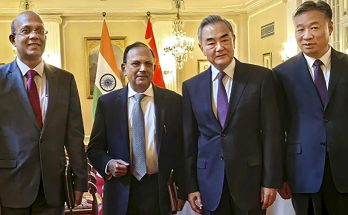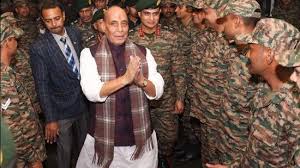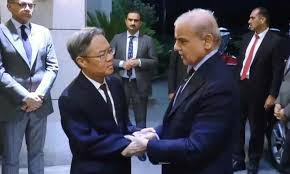 Prime Minister Narendra Modi’s recent visit to China has whipped up expectations not only in India, but possibly across South Asia. There is need for India to recalibrate its ‘South Asia policy’ in the backdrop of Chinese growing strategic interest in the immediate Indian Ocean neighbourhood.
Prime Minister Narendra Modi’s recent visit to China has whipped up expectations not only in India, but possibly across South Asia. There is need for India to recalibrate its ‘South Asia policy’ in the backdrop of Chinese growing strategic interest in the immediate Indian Ocean neighbourhood.
India cannot confuse South Asia policy with neighbourhood policy. China is India’s largest neighbour. Indian concerns over a ‘rising China’ over the past decade-plus is more about China’s ‘increasing influence’ in the South Asian neighbourhood than over the possibility of a revived border episode or a return to war between the two Asian giants.
Even if China were to stop all promised aid and assistance to Pakistan, particularly strategic support and military supplies, India’s problem with Pakistan would remain a stand-alone affair. It is unlikely that India’s problems with Pakistan would be wiped out clean even if it were to settle all disputes with China, starting with the intractable border dispute.
With other South Asian neighbours, India has its own share of bilateral problems all along and India’s ‘China-related concerns’ is the latest with almost every South Asian neighbours, barring Afghanistan and Bhutan, the latter for most parts just recently.
India’s basic premise and problems with the rest of South Asia (always barring Pakistan but at times including Myanmar all the same) has owed to large-scale Chinese investments in these countries. Now that the Modi visit has more than signalled large-scale Chinese investments in India, and also clearance for the opening up of more Chinese diplomatic missions in the country, India should have no cause for complaint.
In the past, India had denied clearance for the Vijinam port project in south Kerala as it had involved Chinese investments. Chinese telecom majors and other investors too had faced clearance-problems in India, given the ‘sensitive nature’ of the infrastructure and possible ‘dual use’ of those facilities. All those assessments and perceptions seem to be changing.
One of the key Chinese investments in India is expected to be on a Delhi-Chennai ‘Bullet Train’. Cooperation in the ports sector as a part of Chinese aid and assistance in infrastructure investment and development may silence Indian critics who had frowned upon similar Chinese investments on the Hambantota and Colombo Port City projects in Sri Lanka. There are other neighbours and specific Indian issues pertaining to Chinese projects and investments there too.
If in the ‘Cold War’ era, some of South Asian neighbours switched faster from a ‘socialist’ form of economic policy to ‘market economy’ than India, they were equally swifter in going to China for aid and assistance, possibly for a political and geo-strategic price.
In both cases, India is slow in catching up. The US as the world’s super-power can do big-time business with China and at the same time, try and stall its rise as a competitor in the global geo-strategic space. So do the European Union (EU) and Russia, the latter seen as reviving erstwhile Soviet Union’s geo-strategic global ambitions.
India too should explore its options, both the opportunities and the challenges. ‘Cautious optimism’ has always been India’s approach to suspect neighbours like China and Pakistan. India has experimented it with Pakistan, time and again. This is the first time such an initiative is being attempted with China. .
India’s South Asia policy has long been influenced and vitiated by perceptions of extra-territorial powers’ roles and interests may compromise India’s interests in the region. The US did not have territorial claims or border disputes with India when it increased its influence and presence in South Asia, at the height of the ‘Cold War’.
The same cannot be said of China now. India does have problems with China – one, on the long-pending border dispute over long stretches of shared border, running up to 4000 km and more. Any negotiated settlement would have to involve Pakistan, at least in parts pertaining to parts of PoK. There have to be overlapping bilateral, though not trilateral negotiations, if the India-China problems have to be resolved.
The ‘Kashmir issue’ and cross-border terrorism are a part of the stand-alone India-Pakistan bilateral problems. They too need to be resolved. A negotiated settlement to India’s Pakistan problems cannot automatically resolve the border dispute with China. But an end to the latter may set the right mood and climate for a successful solution to India-Pakistan problems.
Independent of whichever party has been in power, Indian thinking about problems with individual South Asian neighbours have flowed mostly from two distinct angles. On the one hand, it’s perceptions of priorities in domestic politics. On the other, it’s priorities on the geo-strategic front. Be it, the US or China or Pakistan. India’s problems with China will remain despite the recent visible improvement and increase in trade and economy, aid and assistance. India will need to tackle them directly with China.
Yet, India will have to adopt a new approach to South Asian neighbours. India needs to tell its extra-territorial friends – be it the US or China, EU or Russia – that their meddling in the ‘traditional sphere of Indian influence’ cannot be accepted. It has to make visible progress on border and other contested issues with China, though a real breakthrough may have to wait.
Together, the two initiatives would send out a clear message to the South Asian neighbours that playing ‘one power against the other’ will no longer work.
Author Profile
- India Writes Network (www.indiawrites.org) is an emerging think tank and a media-publishing company focused on international affairs & the India Story. Centre for Global India Insights is the research arm of India Writes Network. To subscribe to India and the World, write to editor@indiawrites.org. A venture of TGII Media Private Limited, a leading media, publishing and consultancy company, IWN has carved a niche for balanced and exhaustive reporting and analysis of international affairs. Eminent personalities, politicians, diplomats, authors, strategy gurus and news-makers have contributed to India Writes Network, as also “India and the World,” a magazine focused on global affairs.
Latest entries
 India and the WorldApril 23, 2025Kashmir terror: India hits back at Pakistan, highlights cross-border linkages
India and the WorldApril 23, 2025Kashmir terror: India hits back at Pakistan, highlights cross-border linkages India and the WorldApril 23, 2025The Century of America and India: Growing Together
India and the WorldApril 23, 2025The Century of America and India: Growing Together In ConversationApril 20, 2025India Can Contribute Largely to Development of Morocco’s Defence Industry: Ambassador
In ConversationApril 20, 2025India Can Contribute Largely to Development of Morocco’s Defence Industry: Ambassador India and the WorldApril 2, 2025Mapping Next Steps for BIMSTEC
India and the WorldApril 2, 2025Mapping Next Steps for BIMSTEC







